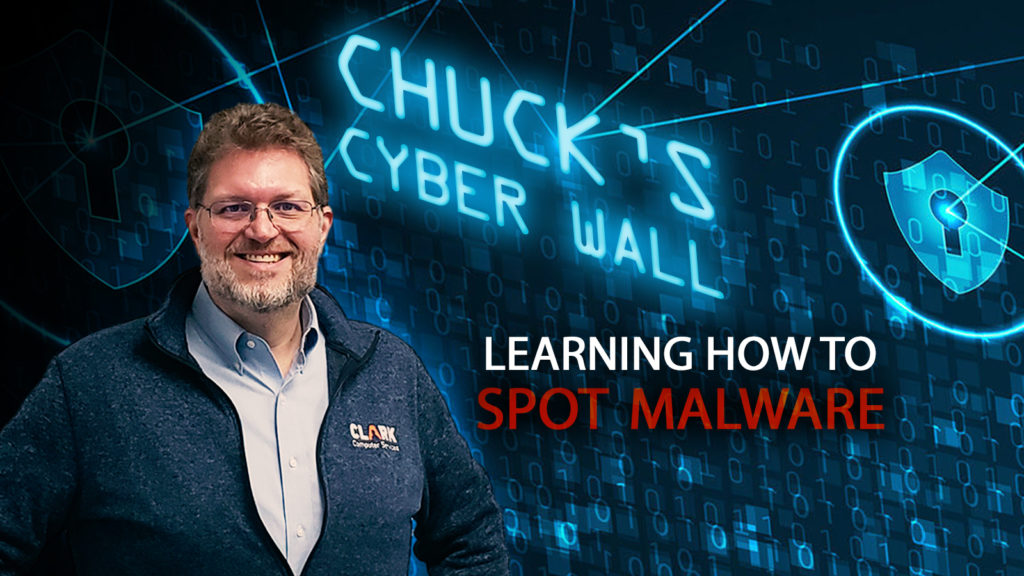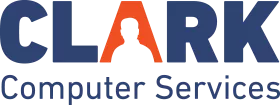A Simple Guide for Learning How to Spot Malware to Protect Your Business
Chuck's cyber wall
Learning how to spot malware is vital because cybersecurity is one of those topics everyone hears about, but few outside of IT feel responsible for. In small and medium-sized businesses, that mindset can be dangerous, because while you might assume that the IT team or service provider handles it all, most malware attacks succeed not because security tools fail, but because someone clicked a link or opened an attachment.
It’s a point that came up recently when talking with a friend who owns a real estate business. At a business conference, one of the speakers told the audience that malware isn’t a threat if you have antivirus software. My wife gave me a look that said “not now,” but I couldn’t help myself, because that’s not how it works. Antivirus is only one piece of the puzzle, and malware is far more aggressive and advanced than ever.
So, let’s talk about what malware really is and how to spot it, especially if you work in a business that doesn’t have an internal IT department.
Understanding How To Spot Malware
“Malware” is short for malicious software. It’s a broad term for things like ransomware, viruses, spyware, and worms. Most people have heard the names, but don’t always know the difference or how much damage these can cause.
This malicious software can slow down your systems, corrupt data, and lock you out of your own files. Even worse, it’s designed to steal financial or personal information, disrupt operations, or give attackers access to your network. A big misconception is that malware only hits large corporations, but this couldn’t be further from the truth. Small and mid-sized businesses, especially those that handle customer data, financial transactions, or confidential communications, are the most targeted.
Part of what makes this a growing problem is that tools used by cybercriminals are becoming more sophisticated, and many threats are designed to bypass antivirus software entirely.
How Malware Spreads
The three major types of malware that most often impact businesses include:
- Ransomware: An attack that encrypts your files and demands payment for access.
- Viruses: These attacks are spread through human action, by sharing infected files, clicking on dangerous links, or plugging in compromised devices.
- Worms: Unlike viruses, worms spread without user input, and once they’re in the network, they move quickly through connected systems.
Each of these can shut down operations, corrupt records, or expose data, and all of them are designed to make money at your expense.
How to Know If You’re Infected
Not every tech hiccup is a cybersecurity crisis, sometimes, a slow computer is just old or overburdened. It’s when problems start showing up suddenly, persistently, or in odd patterns that you should start paying closer attention. One of the most obvious red flags is a screen that locks up with a demand for payment. If you’re told you’ve broken the law or that your files will be deleted unless you pay a fee, it’s almost certainly ransomware. Don’t panic, and definitely don’t pay; get your IT provider involved, or report it directly to CISA.
Another common trick is fake security alerts. These scare tactics, which we refer to as Scareware, are designed to trick you into buying useless “protection” software. You’ll know it’s bogus when the warnings look more like a threat than help, and they keep reappearing until you contact them. Real security tools don’t behave that way.
Sometimes the problem appears as a flood of pop-ups and ads, even on trusted websites. If you find yourself closing out endless windows every time you open your browser, that’s often a sign of adware. Similarly, if your browser homepage suddenly changes to a search engine you’ve never heard of, or won’t stay on the homepage you set, it could mean your settings have been hijacked.
There are also some behind-the-scenes signs. For instance, if you try to open Task Manager or your settings menu and can’t access them, you might be dealing with a more aggressive type of malware blocking your ability to shut it down. And then there are the strange social media posts. If people start asking about things you never posted, or you see bizarre activity tied to your account, that’s a warning that your account, and possibly your device, has been compromised.
Any of these symptoms should prompt an immediate response. Trust your gut. If something seems weird, it probably is, and the sooner you act, the better your chances of limiting the damage.
Why Employees Matter Most
One of the most important facts about cybersecurity is that attackers don’t need to break in; they just need someone to let them in. Clicking a malicious link, downloading an infected file, or using a weak password can open the door for them. That’s why every employee plays a key role in protecting the organization.
Modern malware often uses phishing emails, fake websites, and browser extensions to sneak past antivirus tools. Some versions of malicious software are explicitly built to avoid detection and live inside the browser or in system memory, never installing anything directly. If something seems suspicious, don’t click; close the browser, contact support, and run a scan. And if you don’t know who to call, your company should have a clear cybersecurity plan that includes that information.
Simple Steps to Protect Your Business
Even if you’re not in a technical role, you can make a big difference when it comes to protecting your organization from a cyber attack by following these Best Practices:
- Be cautious with emails and messages that create urgency or fear
- Don’t install software from unknown sources
- Keep your systems and browsers up to date
- Use strong, unique passwords, and enable multi-factor authentication
- If your business doesn’t already do it, schedule regular cybersecurity training
A helpful resource many small businesses use is a cybersecurity audit checklist. These tools help evaluate the basic safeguards every company should have, like secure passwords, updated antivirus tools, strong network protection, and employee awareness training.
Stay Aware, Stay Involved
Cybersecurity threats are real, growing, and increasingly aimed at smaller businesses. While security tools and IT support are critical, the biggest risk often comes down to individual decisions. Your awareness and caution can make the difference between a close call and a serious breach.
You don’t need to be an expert. You just need to be aware and know when to ask questions or report something that feels off. Everyone has a role to play in keeping the business safe.
If you want help getting secure, call us at 301-456-6931 or send an email to support@ccs-rebuild.dreamhosters.com.

Our Industries
Have a Question?
Give us a call
301-456-6931
Our Services
Get a Free Quote
Previous Blogs

Chuck Sperati
Director of Cybersecurity and Marketing

